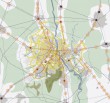Aging infrastructures
Our civil infrastructures – road, bridges, sluices, railways, harbours – represent a tremendous value and is in many countries by far the largest public asset. Because the peak in infrastructure building in Western Europe occurred around the 1960 and 1970s, large shares approach retirement. Maintenance and preservation of existing structures require increasing budgets, but have in many cases insufficient political priority. However, preserving existing networks deserves economic priority over building new roads and railways.
Innovation is needed to determine the right moment of refurbishment or replacement of aging structures. Too early is costly and too late creates the risk of unforeseen closures. New monitoring systems and predictive models, can reduce the future bill for preserving our infrastructures by tens of percentages.
Publications
Does the Dutch court case against Shell have consequences for National Road Authorities?
Last year the Dutch court in the Hague ordered Shell to reduce its CO2 emissions by at least 45% by the end of 2030[1]. The ruling includes emissions from the… Read More
End of car growth?
Official projections from the Dutch government for the growth in car traffic are too high. The government recognized that car mobility grew slower than expected. Therefore, they almost halved the… Read More
Renewal of aging infrastructures
Many countries face aging bridges, tunnels, sluices, quays and other structures. The costs for renovations and replacements of this vital infrastructure, will rise sharply over the coming years and decades.… Read More
Asset management of civil structures
Aging structures require a strongly improved management. In a guest lecture at the TU Delft, I sketched the main challenges and the future of asset management. Download the slides of… Read More
Delhi 2050 – Infrastructure and Urbanisation
Together with partners from India and the Netherlands, I have been involved in making a spatial vision for the future of this Indian metropolis. Delhi is expected to have 35… Read More




